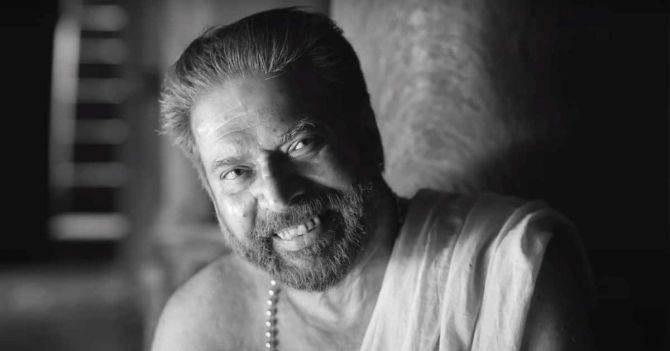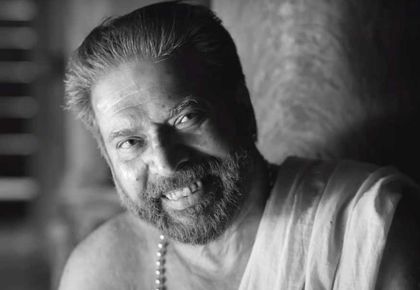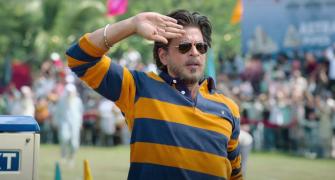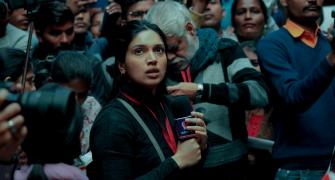Mammootty is towering as the unflinching enigma that prevents Bramayugam from being a middling genre exercise, observes Arjun Menon.

Bramayugam is the third directorial feature by Rahul Sadasivan of Bhoothakaalam (2022) fame, and the film cements the young film-maker's penchant for the psychologically bizarre and macabre material.
The film, set in 18th century Kerala and shot in black and white, follows a cat-and-mouse game of whimsy between death and its closely-hunted prey. The film is a direct descendant of umpteen entries falling under the 'monster movie' and 'haunted house' sub genre of supernatural cinema.
But the dearth of well constructed horror films in Malayalam makes this Mammootty starrer a winner and it shines for its technical finesse and conceptual ingenuity.
Arjun Ashokan plays a nameless plantation slave on the run from his captors. After a deadly encounter with a ghostly presence, he finds solace in a barren mansion referred to as the 'mana'.
The stranger is greeted with open arms by Kodumon Potty (Mammootty), the last remaining inhabitant of the mansion, where the rest of the film unfolds.
The momentary state of relief however, nosedives into a paranoia-fuelled nightmare vision when 'Potty' starts to interact with the unnamed guest, belonging to a lower caste, relegated to being singers of folk songs in the king's service over generations.
A sense of dread starts to mount as 'Potty' slowly starts to usurp his dominance over the clueless guest in more ways than one.
The film also finds another major player in the form of Potty's domestic help and caretaker (Siddarth Bharathan), who does not take well to the intruder. He represents the unknown, a helpless common man ruled over by unchecked power.
In an allegorical sense, the strangely desolate 'mana' in Bramayugam functions as a portrait of society where power corrupts and never lets go, trampling the life of the nameless in the process.
Bramayugam is primarily about how an absolute sense of power slowly mutates into a stasis, where exploitation and ill-treatment become the norm and the subjugation is defined by one's social identity, in this case, caste.
Bramayugam functions as a chamber piece, heavy on banter and starch dialogues fitting the era it is set in.
It also draws on German expression-inspired imagery and the interplay between light and shadows as part of its visual landscape, keeping things visually charged.
There are obvious callbacks to Francis Ford Coppola's version of Bram Stoker's Dracula, with the use of imposing shadows, auditory suggestion and wall to wall sound design, enhancing the ever changing character dynamics.
Shehnad Jalal's camera finds interesting ways to make the black and white imagery look subtle, rarely calling attention to itself. The shadows and shrouds of darkness just exist in the deep pockets at the edges of the frame, and the film-maker's use the single location to drive home the claustrophobia of being stuck in a place.
The rousing musical score by Christo Xavier is pulsating and adds life to the film’s not-so-hurried pacing and atmospherics.
Few of the jump cuts and smash cut choices by Shafique Mohammed Ali add to the intrigue of the film's tone.
Mammootty is towering as the unflinching enigma that prevents Bramayugam from being a middling genre exercise.
There is authority and panache in his interpretation of evil.
There is seldom a false note in his grandiose scenery chewing, an aspect that the role demands by virtue of the character design.
The actor lifts the film from the occasional lulls through his electric charisma that sells the most outrageous of lines and character moments with aplomb.
Arjun Ashokan is also well cast as the clueless stranger, forced to confront his wildest nightmares.
There is deft allure to the way he compliments Mammootty's larger-than-life persona, with a more toned down approach.
Siddarth Bharathan too looks comfortable navigating the hellhole with a lived-in quality and world weariness in the way he shifts his loyalties and affiliations.
Amalda Liaz gets the shorthand of the deal as the sole female performer, confined to just two major scenes in the movie.
Rahul Sadasivan reworks the staples of Muthassi Kathas and Ghostly Folklores from our culture, where Goblins and Black Magic reshape destinies.
The director achieved a similar effect in Bhoothakaalam, where he took a dysfunctional family drama into realms of elevated horror to address the concept of shared trauma.
Bhoothakaalam triumphed on its minimalist storytelling choices and you can see a similar narrative economy in Bramayugam where the sense of scale and expanse is conveyed through a limiting setting.
There are attempts to explore the issues of caste-based suppression and cycles of oppression that linger on in our society, over the ages in different forms.
But the film is too invested in the interplay between the three primary characters to give any real underlining weight to the social commentary angle after a point.
Bramayugam is a brave star vehicle, facilitated by the meeting of two distant voices in Mammootty, a star known for his late career winning streak of experimental outings and a director in solid control of his thematic ideas.
There is so much to chew on in this audacious super star vehicle that subverts all expectations, albeit in a novel way.










